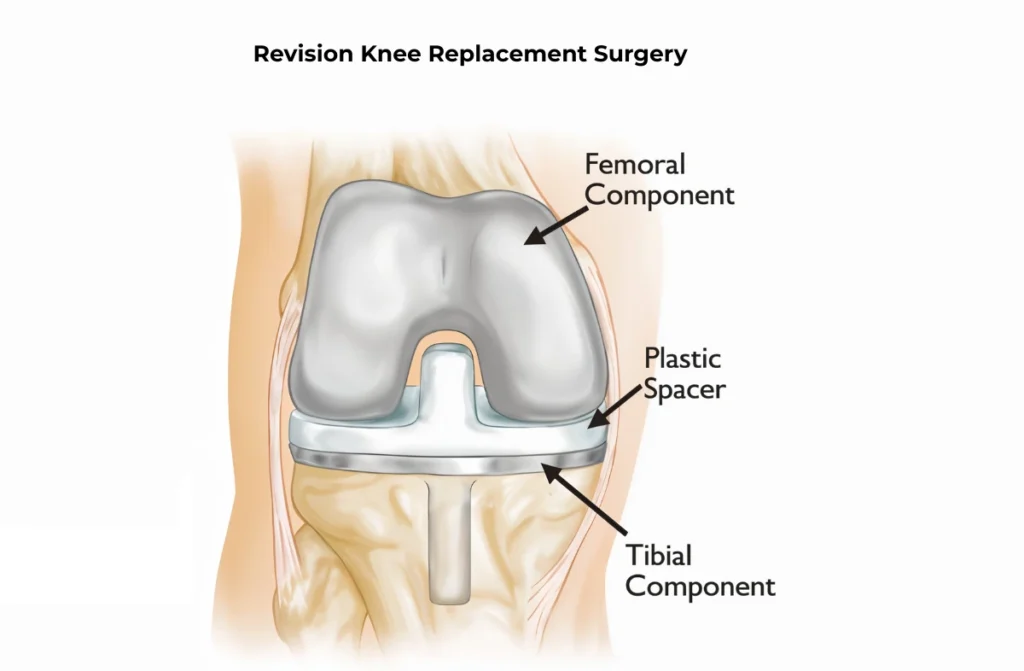When a knee replacement implant begins to fail, revision surgery can restore comfort and ease of movement. Issues such as implant wear, misalignment, or other complications can lead to discomfort, instability, and limited function. Revision knee replacement removes and replaces the initial implant to alleviate pain and enhance knee function. For patients facing implant-related issues, revision surgery can provide a path to relief and revision knee replacement recovery.
What is Revision Total Knee Replacement?
Revision knee replacement surgery involves replacing an existing knee implant with a new one. This procedure is necessary when a previous knee replacement fails due to factors like infection, wear and tear, loosening of the implant, or misalignment. Unlike the initial procedure, revision surgery is more complex and requires a highly experienced orthopedic surgeon. Revision knee replacement surgery addresses the problems that may arise from a prior knee replacement. This type of surgery is typically more intricate than the initial procedure, due to factors like:
- Formation of Scar Tissue: Previous surgeries often leave scar tissue around the knee, making implant removal more complicated.
- Bone Loss: Bone erosion around the old implant can require additional care to ensure a secure and stable fit for the new implant.
- Muscle Weakness: Long-term coping with a malfunctioning implant can weaken surrounding muscles, affecting postoperative recovery.
Despite these complexities, revision surgery has the potential to deliver substantial improvements in pain relief and knee stability.
When to Consider Revision Knee Replacement
Certain signs indicate that your knee implant may be deteriorating, and revision knee replacement surgery could become necessary:
- Implant Loosening or Wear: Implants can lose stability or wear out over time, causing pain and discomfort.
- Infection Around the Implant: Infections near the implant site require immediate attention and may necessitate surgical intervention.
- Knee Instability: A knee that feels weak or gives way when bearing weight may benefit from revision surgery.
- Ongoing Stiffness: If stiffness persists despite physical therapy, revision surgery might be considered.
- Fractures Near the Implant: Fractures close to the implant can disrupt joint stability, often needing surgical correction.
Experiencing these symptoms should prompt a visit to Dr. Omer Sheriff for a comprehensive evaluation to determine the best treatment path.

Identifying a Failing Knee Implant: Key Symptoms
Recognizing a failing knee implant isn’t always straightforward. However, several key symptoms could indicate the need for revision:
- Unrelenting Pain: Pain that doesn’t improve with rest or pain management strategies.
- Chronic Swelling: Ongoing or severe swelling around the knee joint, especially following physical activity.
- Instability in Movement: A sensation that the knee might give out or lack support.
- Reduced Range of Motion: Difficulty fully bending or straightening the knee.
- Movement Limitations: Reduced ability to walk or stand comfortably, impacting daily activities.
- Infection Warning Signs: Symptoms such as redness, warmth around the knee, or fever.
- Unusual Noises: Clicking, popping, or grinding sounds may indicate implant malfunction.
If you observe any of these symptoms, Dr. Omer Sheriff can conduct a thorough assessment to explore your options.
Preparing for Revision Knee Replacement Surgery
Proper preparation plays a vital role in the success of revision knee replacement surgery. Here’s how patients can get ready:
- Full Health Evaluation: Your doctor will assess your overall health to confirm readiness for surgery and address any health issues that could impact recovery.
- Diagnostic Imaging: X-rays, CT scans, and other imaging tools provide detailed visuals of the knee joint, aiding in the surgical planning process.
- Home Environment Preparation: Arranging for a recovery-friendly space such as setting up mobility aids and ensuring accessible areas for rest can streamline the post-surgery period.
Taking these steps helps lay a foundation for effective recovery and minimizes potential complications.
Risks and Complications: What to Know
As with any major surgery, revision knee replacement carries certain risks. Understanding these can help you make informed decisions about your treatment:
- Infection Risk: Revision procedures carry a higher risk of infection than initial surgeries due to the complexity of the process.
- Blood Clot Formation: Reduced mobility after surgery can elevate the risk of blood clots.
- Bone Fractures: Fragile bones near the implant may be more susceptible to fractures.
- Potential Implant Instability: Occasionally, the new implant may not fully integrate with the bone, which could lead to loosening over time.
- Nerve Damage: Nerve injury is a possibility, potentially resulting in tingling, numbness, or weakness in the leg.
Dr. Omer Sheriff and his team will guide you through these risks, helping you weigh the benefits of revision surgery against potential challenges.
Alternative to Knee Revision Surgery
In some cases, alternatives to knee revision surgery may be viable options to address knee pain or instability. These include:
- Physical Therapy: Tailored exercise programs can strengthen muscles around the joint and improve mobility, offering an effective alternative to knee revision surgery.
- Medications: Anti-inflammatory drugs or injections, such as corticosteroids or hyaluronic acid, are commonly used to reduce pain and swelling. They provide relief during revision knee replacement recovery or as an option before surgery.
- Minimally Invasive Procedures: Arthroscopy may be utilized to clean the joint or resolve minor issues, which can postpone or eliminate the need for recovery from revision knee replacement surgery.
- Assistive Devices: Braces or orthotics can help stabilize the knee and alleviate discomfort, making them a suitable alternative to knee revision surgery for certain patients.
These alternatives are frequently recommended for patients who are unfit for surgery or as a first-line approach before revision knee replacement recovery is considered essential.
The Surgical Process: Steps to Expect
Here’s an overview of what occurs during revision knee replacement surgery:
- Anesthesia Administration: Either general or spinal anesthesia will be used to ensure comfort during the procedure.
- Incision at Previous Site: The surgeon will make an incision along the original scar to reach the joint.
- Removal of Old Implant: The initial implant is carefully detached. In some cases, specialized techniques are required to separate the implant from the bone.
- Bone Restoration and Repair: Damaged bone will be addressed, and additional components or bone grafts may be added to support stability.
- New Implant Placement: A new, reinforced implant is put in place, often with extended stems or advanced materials to provide added support.
- Wound Closure and Drainage: The incision is closed, and a drain may be placed to prevent fluid buildup and promote healing.
Each step is performed with precision to maximize recovery outcomes.
Recovery From Revision Knee Replacement
The revision knee replacement recovery process following revision knee replacement surgery can be more involved than recovery from revision knee replacement from an initial replacement, but a return to mobility is achievable with commitment:
- Physical Therapy and Rehabilitation: Structured therapy helps regain knee strength and flexibility.
- Pain Control: Medications and techniques for pain management will help keep discomfort manageable.
- Monitoring and Follow-Ups: Regular check-ins will track your healing progress and address any concerns early.
Achieving a successful recovery depends on your dedication to physical therapy, adherence to medical advice, and proactive management of your recovery plan.
Conclusion
For those experiencing implant complications, revision knee replacement surgery offers an effective pathway to restored mobility and quality of life. Though more complex than a primary knee replacement, revision surgery can bring lasting relief from pain and improve knee stability. With expert guidance from Dr. Omer Sheriff, you can navigate this journey with confidence, supported by a team committed to your best possible outcomes.
Read More: Hip Replacement Surgeon.





